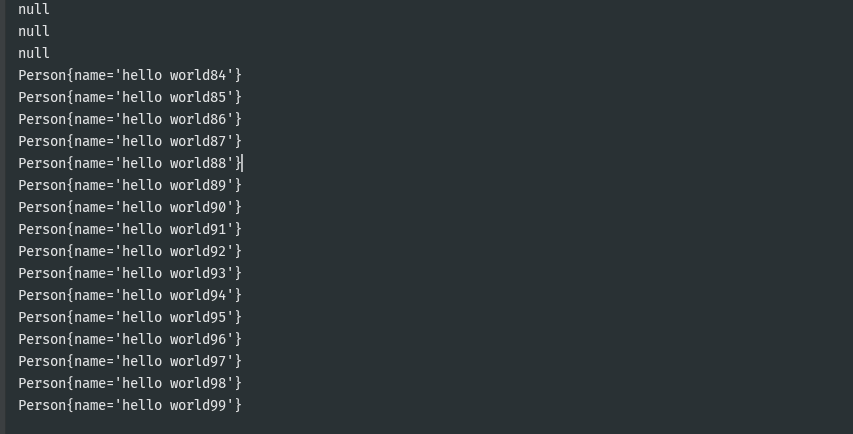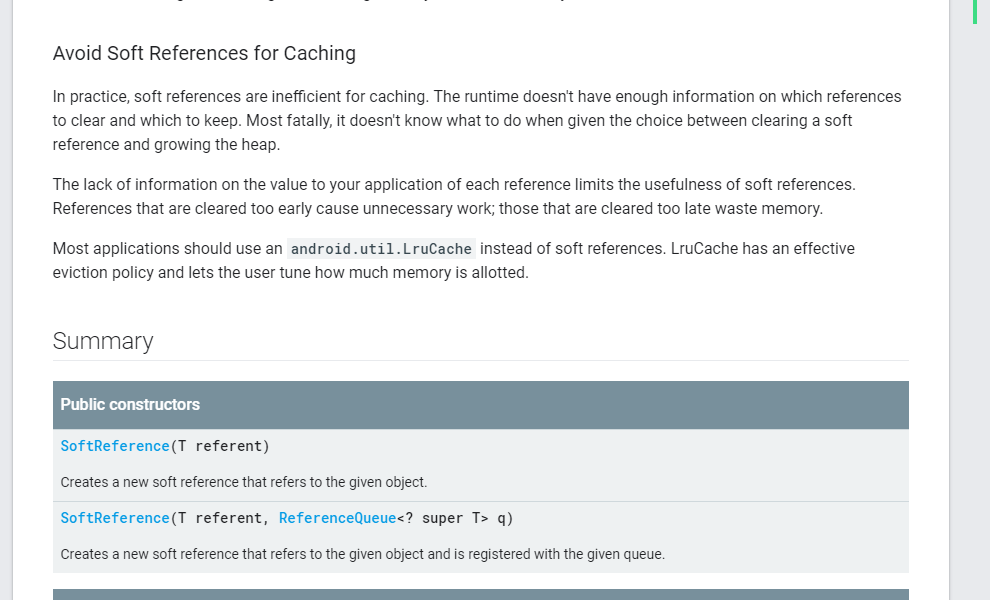碎碎念
JDK1.2之后对对象的引用进行了划分,分别存在有强引用,软引用,弱引用,虚引用
- 强引用(Strong Reference)
强引用是最普通的引用,如果一个对象是强引用。那么垃圾回收器绝对不会回收它。当内存空间不足时,java虚拟机会抛出OutOfMemoryError是程序异常终止,但是不会回收强引用对象。
- 软引用(Soft Reference)
一个对象如果是软引用的话,那么当程序内存不足的时候,垃圾回收器会回收它。那内存空间不紧张的时候。它就一直存在。也就意味着我们是使用它。
- 弱引用(Weak Reference)
弱引用相比于软引用它的声明周期更短。当垃圾回收器在工作的过程中,发现了弱引用对象,不管当前内存是否紧张。都会将其回收。但是GC的触发不是特别的频繁。所以不会那么快发现这个引用。
- 虚引用 (Phantom Reference)
虚引用顾名思义,就是形同虚设,与其他几种引用都不同,虚引用并不会决定对象的生命周期。
设计一个软引用缓存集合
由于种种因素,我们需要缓存一些数据在内存中,假设我们现在需要缓存的数据是Person类。( 注意Person对象很大,像BitMap一样)
public class Person {
private String name;
private byte[] datas = new byte[1024*1024*100];
public Person(String name) {
this.name = name;
}
@Override
public String toString() {
return "Person{" +
"name='" + name + '\'' +
'}';
}
}
正常情况下,我们是直接使用如下的代码
public class Main {
public static void main(String[] args) {
Map<Integer, Person> pp = new HashMap<>();
for (int i = 0; i < 100; i++) {
Person person = new Person("hello world");
pp.put(i, person);
}
for (int i = 0; i < 100; i++) {
System.out.println(pp.get(i));
}
}
}
但是一运行,你就会发现出现如下的错误

因为Person的数据量太大了,导致JVM出现了OOM。那么有没有办法容纳下这么多的数据,而不会出现OOM呢? 嗯~ 没有办法。 因为JVM内存是有限制的,你没有办法无节制的往内存中存放东西。但是我们可以换个角度,来思考。尽可能的利用JVM内存呢?嗯~ 可以的,我们可以利用上面所说的软引用特性来设计一个缓存集合。
/***
* 软引用应用设计集合
* @param <K> Key
* @param <V> Value
*/
public class SoftReferenceCache<K, V> {
private Map<K, SoftReference<V>> mCache = new HashMap<>();
/**
* 存放数据
*
* @param k 数据Key
* @param v 数据Value
*/
public void put(K k, V v) {
mCache.put(k, new SoftReference<V>(v));
}
/**
* 存放数据
*
* @param k 数据Key
* @return 返回数据Value
*/
public V get(K k) {
SoftReference<V> reference = mCache.get(k);
if (reference != null) {
return reference.get();
}
return null;
}
}
然后使用上面的 SoftReferenceCache 来进行存储
public static void main(String[] args) {
SoftReferenceCache<Integer, Person> softReferenceCache = new SoftReferenceCache<>();
for (int i = 0; i < 100; i++) {
softReferenceCache.put(i, new Person("hello world" + i));
}
for (int i = 0; i < 100; i++) {
System.out.println(softReferenceCache.get(i));
}
}
运行后,你会发现不会出现OOM。但是会存在有被GC回收的对象。这个时候,你需要在自己的逻辑上增加三级缓存。

如何知道一个对象被GC回收呢?
我们想要知道一个对象什么时候会被GC回收。就需要利用引用队列ReferenceQueue,GC在准备回收一个对象时,如果发现它还仅有软引用(或弱引用,或虚引用)指向它,就会在回收该对象之前,把这个软引用(或弱引用,或虚引用)加入到与之关联的引用队列(ReferenceQueue)中,这样我们就知道,对象被GC回收了。
public static void main(String[] args) throws InterruptedException {
ReferenceQueue<Person> queue = new ReferenceQueue<>();
WeakReference<Person> cc = new WeakReference<>(new Person("hello"), queue);
System.gc();
Thread.sleep(2000);
Object object;
while ((object = queue.poll()) != null) {
System.out.println("GC回收了>>>>:" + object);
}
}
上述代码,可以知道cc什么时候被回收

Android 中的 Reference
- Android 不建议使用
软引用来做缓存,因为Android Runtime无法感知,应该通过GC来回收内存,还是增加APP的栈内存。官方推荐我们是LruCache

- 当我们能够了解一个对象的销毁时机,就意味着我们能对一些本该销毁的对象进行反应。 也就是
内存泄露的检测。LeakCanary底层就是使用引用队列进行对Activity、Fragment进行检测的。